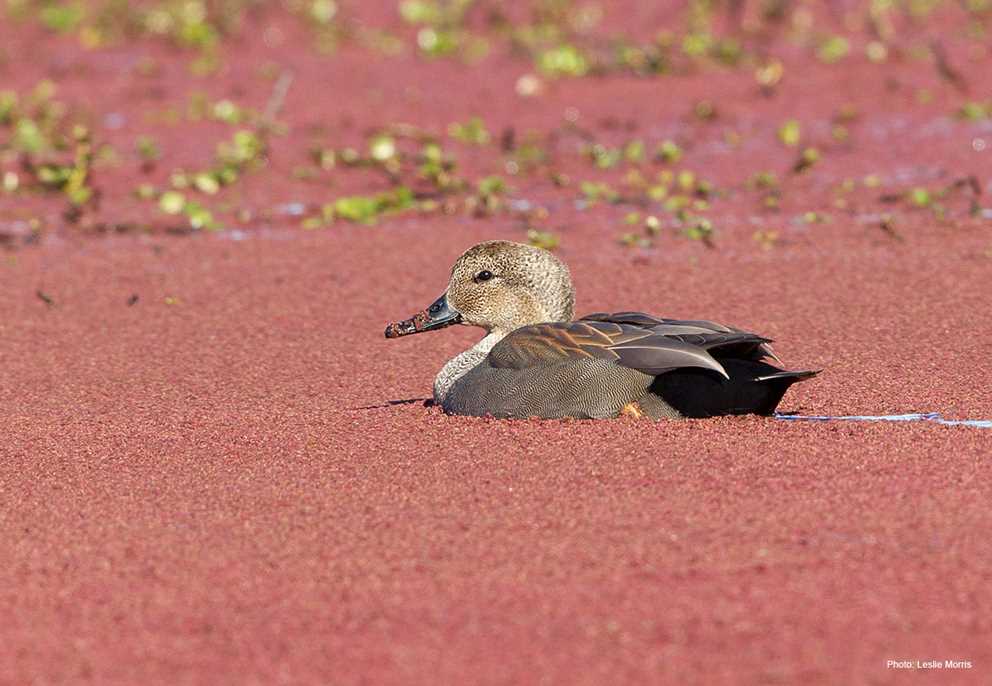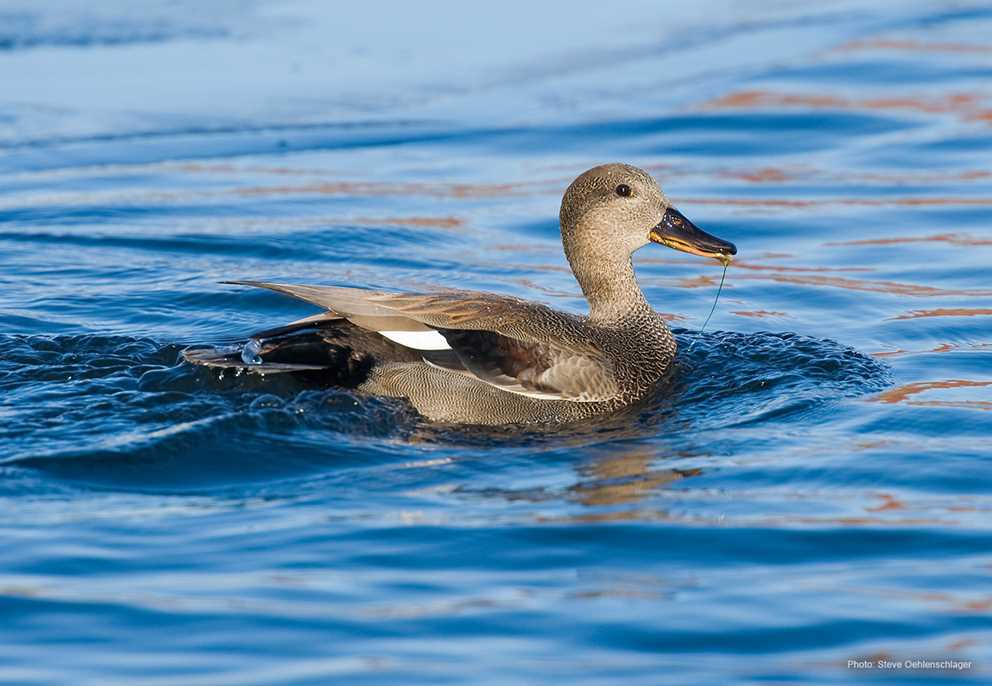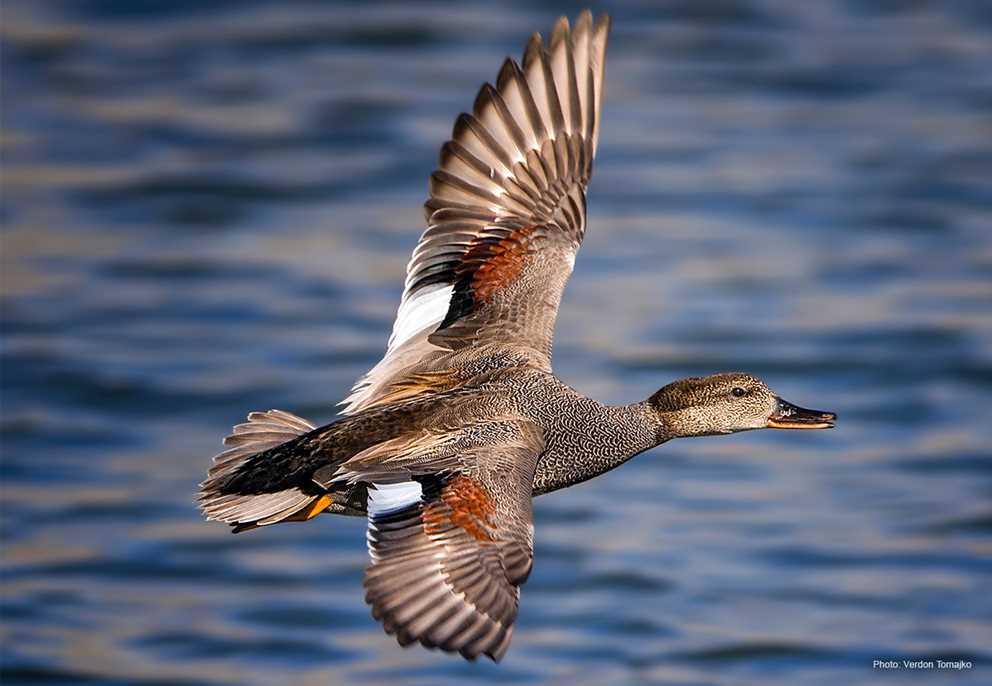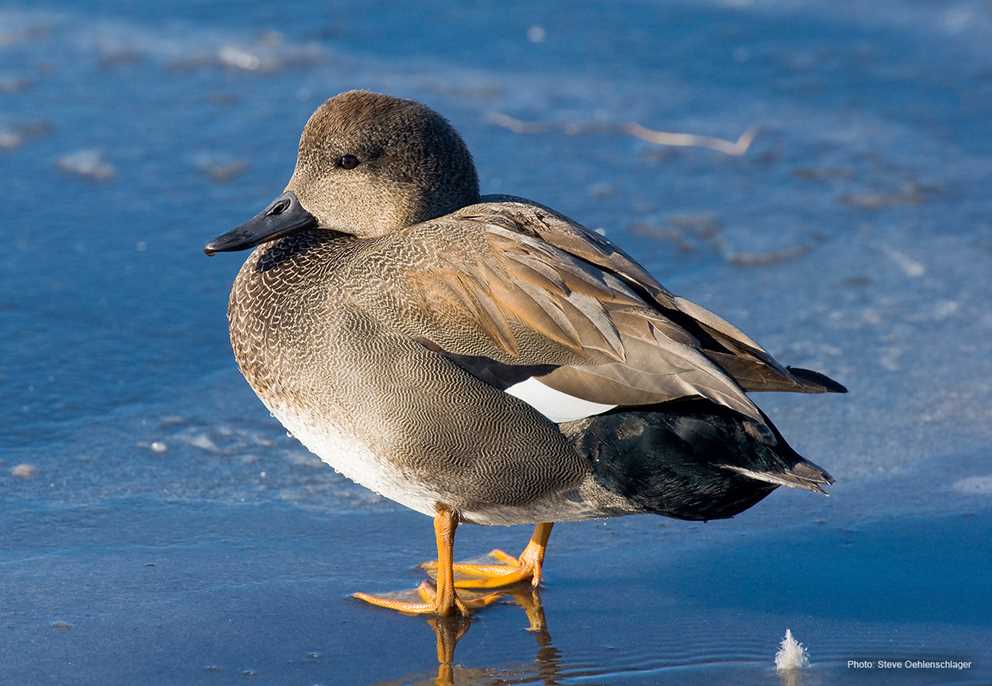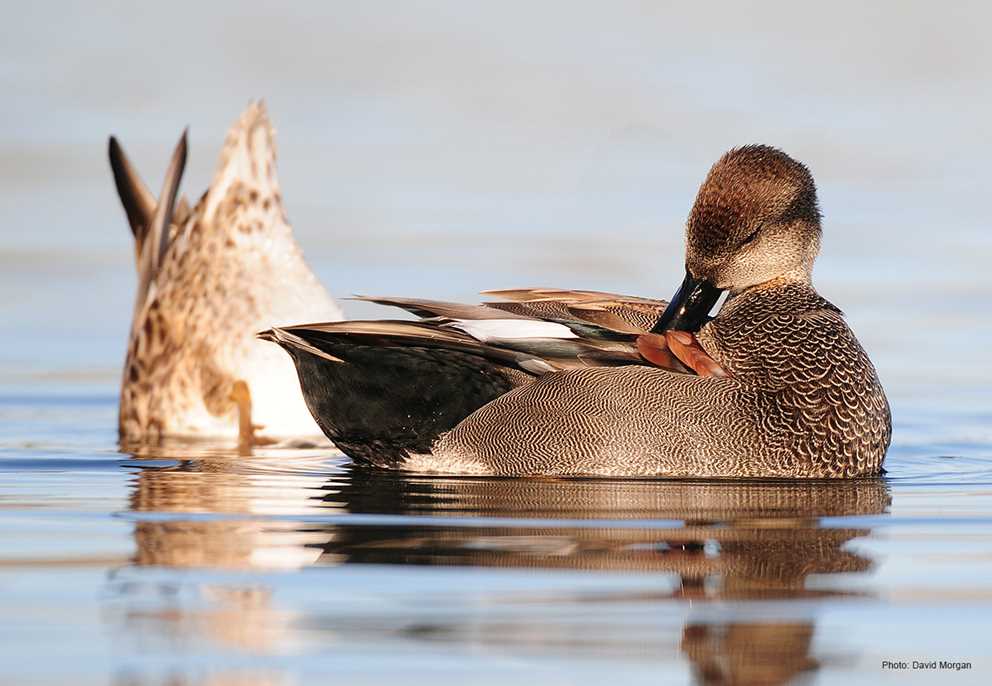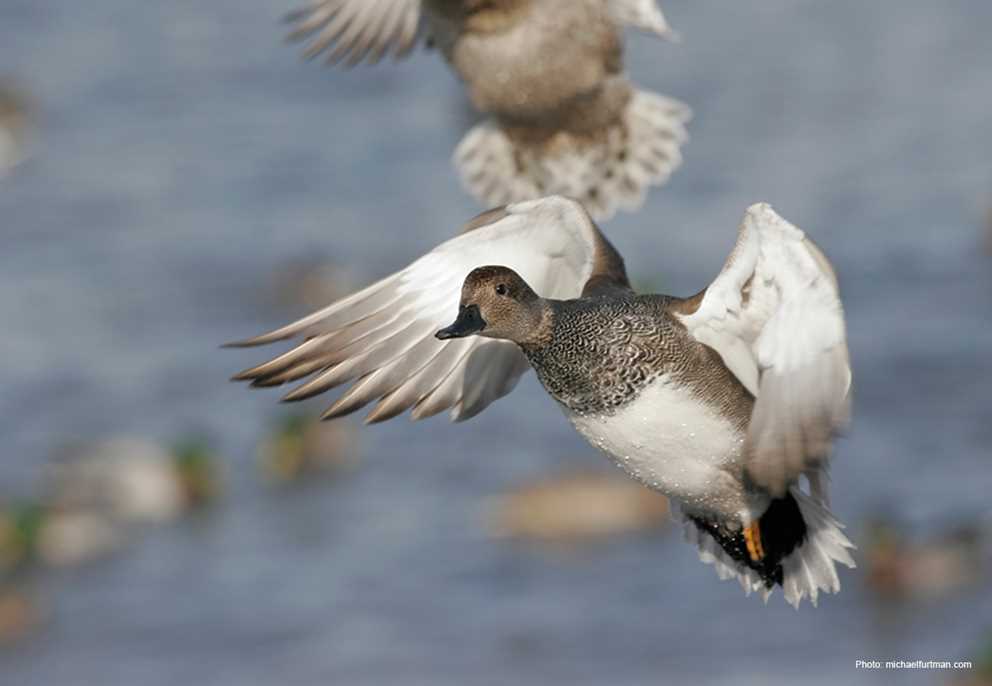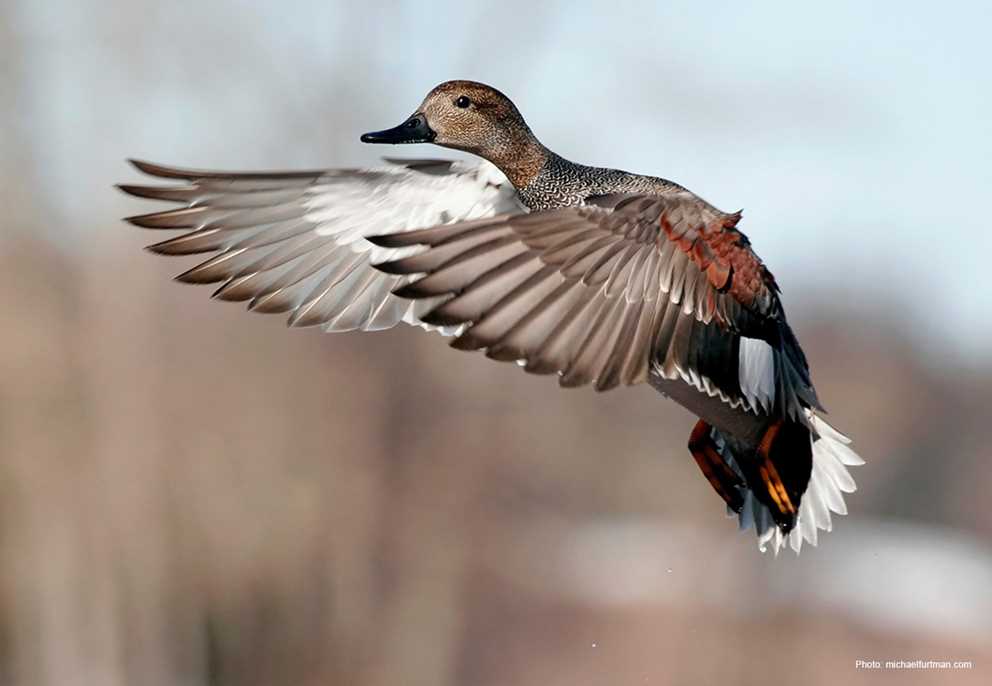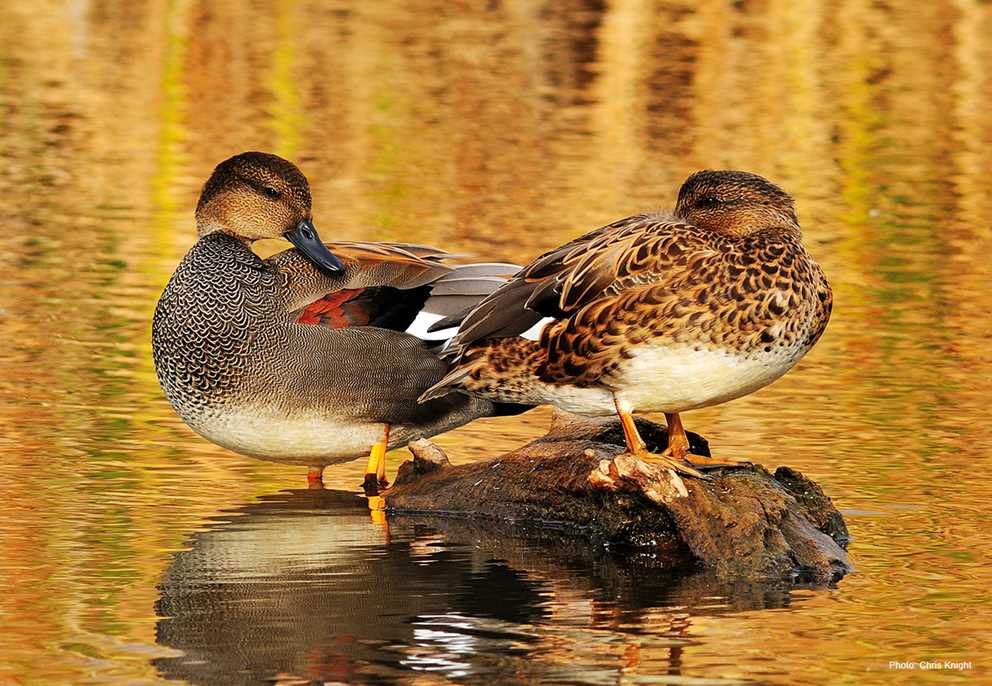Overview
The Gadwall is a medium-sized dabbling duck with a circumpolar distribution. In North America, Gadwall breed from the Great Lakes across the Northern Great Plains into Alberta, with smaller numbers breeding in British Columbia, throughout the Intermountain West, and in California. Gadwall winter across the United States and in Mexico. Gadwall nest in tall vegetation near water and show a preference for nesting on islands. Winter habitat is fresh and brackish wetlands with abundant aquatic vegetation on which they primarily forage. Males have grayish-brown heads, sometimes showing cinnamon on the forehead, and faint purplish iridescence on the crown. In flight, the wings shows a notable white speculum, with chestnut and black median and lesser covert feathers. Females are buffy tan overall, with more mottled plumage, they have a white belly and show a slightly smaller white speculum. The bill is orange with variable black markings, and the feet and legs are pale yellow.
Gadwall prefer dense upland grass, brush or herbaceous cover for nests, usually in relatively close proximity to wetlands, and they make extensive use of islands when they are available.
Description
Key Identification Features:
- In flight, the wing shows a notable white speculum, with chestnut and black median and lesser covert feathers, and the white belly contrasts with the dark breast and vent.
- Males are grayish-brown. The mantle, back and flanks are gray with black and white vermiculation. The upper breast is black, lower breast and belly white, the rump and vent are black, and the tail is grayish-brown. The bill is narrow and black to slate gray, and the feet and legs are yellow.
- Females are buffy tan overall, with more mottled plumage, they have a white belly and show a a small white speculum. The bill is orange with variable black markings, and the feet and legs are pale yellow.
Male/Female Average Length and Weight
- Mass: Males 1.3–2.8 lbs; Females ~.1–2.3 lbs
- Wing length: Males 10.3–11.1 in; Females 9.7–10.6 in.
Male Identification:
- Alternate (Breeding) Plumage: Males have a grayish-brown head, sometimes showing cinnamon on the forehead, and faint purplish iridescence on the crown. The mantle, back and flanks are gray with black and white vermiculation. The upper breast is black, lower breast and belly white, the rump and vent are black, and the tail is grayish-brown. The bill is narrow and black to slate gray, and the feet and legs are yellow. In flight, the wings show a notable white speculum, with chestnut and black median and lesser covert feathers.
- Basic Plumage: Overall brownish-gray, white belly.
Female Identification:
- Alternate (Breeding) Plumage: Females are buffy tan overall, with more mottled plumage, they have a white belly and show a slightly smaller white speculum. The bill is orange with variable black markings, and the feet and legs are pale yellow.
- Basic Plumage: Overall brownish-gray, white belly, fairly dull plumage.
In-Flight Identification:
- Male: In flight, the wings show a notable white speculum, with chestnut and black median and lesser covert feathers, and the white belly contrasts with the dark breast and vent.
- Female: The same white speculum is smaller but noticeable on the female in flight.
Vocalizations:
- Male Calls: Males emit a grunt like “araeaeb”, especially in flight, sometimes singly or in short series of 3 or 4 grunts.
- Female Calls: Females have nasal “quack” that is higher pitched than the Mallard female.
Similar Species:
- The overall grayish-brown plumage of males, with the black rump and undertail coverts and white speculum separates Gadwall from other species in North America. The drab brownish gray female is superficially similar to other female puddle ducks, but the white belly contrast, and the white speculum, and the orange bill with variable black central markings are useful marks to separate Gadwall from other female puddle ducks.
Habitat Preferences
- Breeding: Breeding Gadwall are typically found on freshwater or brackish wetlands with abundant submerged vegetation that comprises most of their diet. Nesting birds use upland habitats with dense grass, herbs, or brush, usually in close proximity to water. Nesting gadwall disproportionately use islands for nesting.
- Migration and Wintering: Winter habitat is variable and includes freshwater and emergent wetlands, forested wetlands and swamps, and coastal marshes and estuaries. Wintering Gadwall are almost always found on wetlands with abundant submerged vegetation that is their primary food source.
Foraging Habits and Diet
- Gadwall eat a variety of species of aquatic vegetation, favoring leafy portions of pondweed, naiad, widgeon grass, and milfoil among others. Invertebrates comprise a low proportion of their diet, except by females during breeding season when invertebrates are needed for egg production. Gadwall are dabblers, and feed by grazing or tipping up to reach submerged aquatic plants. Where American Coots are feeding on vegetation in deep water, gadwall will steal food as the coots surface with vegetation. Gadwall do not feed in uplands or dryland harvested crop fields like many other species of dabbling ducks.
Breeding Habits
- Monogamy: Gadwall are seasonally monogamous.
- Nest Locations: The nest is usually in upland areas with dense grass, herbs, or brush, and in close proximity to water. They also show a preference for nesting on islands.
- Clutch Size: Clutch size averages 8–12 eggs. The eggs are creamy white to grayish green, oval, and average 2.2 by 1.6 in. The incubation period is 26 days. They will renest if nest loss occurs during laying, and possibly in early brood rearing.
Migration & Distribution
- Fall Migration: Gadwall probably depart breeding areas in September or October depending on latitude. They arrive in winter areas from October through November.
- Spring Migration: Spring migration from February-April with arrival on breeding areas in late April to May. Birds nesting in Intermountain West, Southern Great Plains, and Pacific Coast habitats may be nonmigratory.
Conservation Status
- IUCN Status: Least Concern
- Population Status: In North America, the USFWS Waterfowl Population Status, 2024 indicated a population of 2,284,000 birds. Gadwall populations, unlike many other species of waterfowl, have increased significantly since the early 1990s though populations continue to fluctuate annually with wetland abundance across most of their prairie nesting range.
- Conservation Concerns: The primary threats include habitat loss.
- Conservation Focus: Conservation efforts focus on protecting and restoring breeding, migration, and winter habitats.
Harvest Information
- An average of 983,479 Gadwall were harvested per season across the US during the 2019 through 2022 hunting seasons.
- Gadwall harvest is highest in the Mississippi Flyway, accounting for 40 to 50 percent of the total US harvest.
- The top three harvest states for Gadwall across the 2019 –2022 hunting seasons were Arkansas (682,450), Texas (646,992), and Louisiana (388,744).
